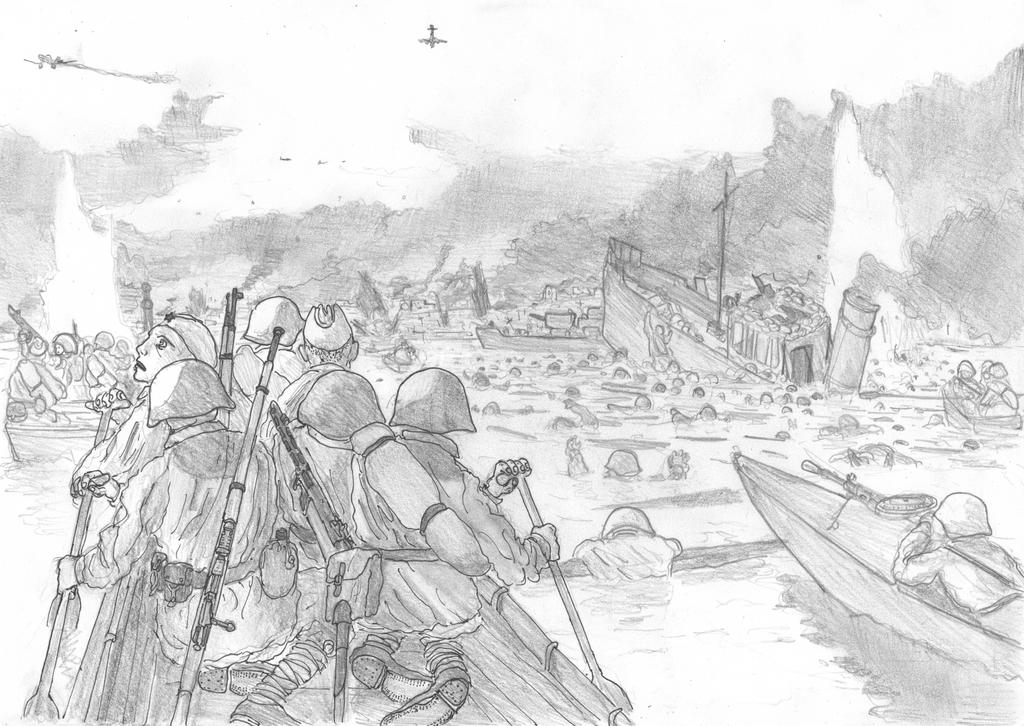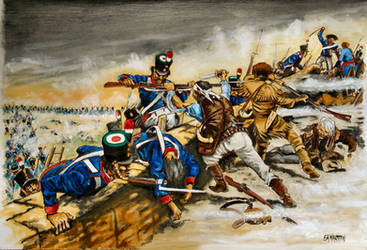ShopDreamUp AI ArtDreamUp
Deviation Actions
Description
ENGLISH (based on A. Beevor, Stalingrad, the Fateful Siege, V.Grossman, A Writer at War, V. Chuikov, The Battle of Stalingrad, C. Merridale, Ivan's War)
ITALIANO: (basato su A.Beevor, Stalingrado, V.Grossman, A Writer at War, C.Merridale, Ivan's War, V. Chuikov, La Battaglia di Stalingrado)
"I am a Communist! I have no intention of abandoning the city!" (Lt.General Alexandr Rodimtsev, commander of the 13th Guards Rifle Division)
PREMISE:
By mid September, 1942, the german 6th division was fighting for the city of Stalingrad since half a month. The soviet 62nd army, commanded by general Chuikov, was in a desperate situation, holding just a strip of land before the river Volga: in certain areas of the front, the German were only 200 meters from the shores. The Mamaev Kurgan, a hill dominating the city, had recently fallen to the germans, and was used as an artillery position.
On September 14th, 1942, 2 PM, general Aleksandr Rodimtsev, his uniform tattered and dirty, reached the command post of Vassilij Chuikov. Rodmitsev was a true leader of men and a former hero of the Spanish Civil War, where he was awarded the Hero of the Soviet Union at the battle of Guadalajara in 1937, against the italian blackshirts. The orders from Chuikov were to bring his 13th Guards Rifle Division on the western shore of the Volga as soon as possible, to reinforce the 62nd army positions and repel the german offensive. The situation was hopeless, but when Chuikov asked Rodimtsev about his morale, he famously answered "I am a Communist! I have no intention of abandoning the city!"
The division, formed by 10.000 men, had reached the eastern shore of the Volga after a forced march. Before the docks, there was a small woodland; the marching soldier could see the smoke from the burning city rising behind the trees.
THE CROSSING:
The Volga is one kilometer large between its eastern and western shore in Stalingrad, and that's why river crossing during the battle of Stalingrad usually happened in night hours, up until dawn. German artillery and aircraft would have had easy targets, aiming the slow ferries and barges crossing the river. Still, the urgency of the situation forced Rodmitsev to order the crossing at 5 PM, during the twilinght hours, with the sun still up. The soldiers were embarked not only on soviet military gunships, but also on any civilian vessel avaiable: ferries, barges and even rowboats and kajaks. To hasten their deployment in the city, the soldiers were ordered to carry just their personal weapons and ammunitions.
The sky was clear and the water calm. The soldiers, according the war correspondant V. Grossman, were all silent as they crossed the river towards the burning hell and the towering smoke of the western shore. After a while, the german artillery, machineguns and bombers started their fire on the convoy. Water columns, formed by artillery shells, could be seen all around. Grossman describes a small ferry being hit by a big calibre shell: "There was a flash of flame, dark smoke enveloped the ferry, an explosion was heard, and immediately afterwards, a drawling scream as if born from this thunder. Thousands of people saw immediatly the green helmets of the men swimming among the wreckage of wood rocking on the surface of water".
The Guards fought relentlessly during the next days, distinguishing itself in the train station sector, in the Mamaev Kurgan (which it recaptured on the 16th). A bunch of men lead by Lt. Yakov Pavlov captured a large building in 9th January square starting the legend of the so called Dom Pavlovna, which they held until November, 25th. But there was an heavy price to paid: out of 10.000 men, only 320 survived the battle of Stalingrad.
VISUAL SOURCES:
General Chuikov:
General Rodimtsev:
The central area of Stalingrad: chindits.files.wordpress.com/2…
The docks of Stalingrad:
Stalingrad seen from the western shore:
The Crossing of the Volga:
IN POPULAR CULTURE:
The famously inaccurate movie Enemy at the Gates opens with a daylight river crossing which is pretty similar to Rodmitsev's and probably inspired by that. Ferries and barges can be seen, and the urgency and desperation of the situation is stressed up a little too much: the soviet soldiers are portrayed like cattle guided by commissars-sheepdogs (a metaphor that even in the fifties would have looked a bit too much) and none of them have weapons. While it's indeed true that 1/10 on the men of the 13th had no weapons at their arrival in Krasnaya Sloboda, according to all the sources I've read they did indeed received personal weapons before the crossing. These things aside, it's a great scene. There is a powerful moment in which the soldiers see Stalingrad in flames for the first time: you can only see it reflected on their terrorized faces, before a crescendo in the soundtrack lead to a panoramic view of the Volga crossing. Sadly this small segment (which is my favourite) can not be found on youtube:
The movie inspired one the most memorable sections of the original Call of Duty videogame, in 2003:
ITALIANO: (basato su A.Beevor, Stalingrado, V.Grossman, A Writer at War, C.Merridale, Ivan's War, V. Chuikov, La Battaglia di Stalingrado)
"Sono un comunista! Non ho alcuna intenzione di abbandonare la città!" (Generale Alexandr Rodimtsev, comandante della 13° Divisione Fucilieri della Guardia)
PREMESSA:
A metà settembre 1942, erano passate più di due settimane da quando la 6° armata tedesca aveva dato inizio alla lotta per la città di Stalingrado. La 62° armata sovietica, comandata dal generale Chuikov, era in una situazione disperata, con in mano solo un lembo di terra tra i tedeschi e il fiume Volga: in alcune zone del fronte, gli invasori erano a soli 200 metri dalle rive. Il Mamaev Kurgan, un'altura che domina la città, era da poco caduto in mano ai tedeschi, offrendo loro un'importante postazione di artiglieria e di avvistamento.
Il 14 settembre 1942, alle 14, il generale Aleksandr Rodimtsev, l'uniforme stracciata e infangata, raggiunse il posto di comando di Vassilij Chuikov, sulla riva ovest del Volga. Rodimtsev era un vero leader di uomini e di un eroe della guerra civile spagnola, dove nel 1937 si era guadagnato il titolo di Eroe dell'Unione Sovietica , contro le camicie nere italiane, nella battaglia di Guadalajara.
Gli ordini di Chuikov prevedevano che egli spostasse la sua 13° Divisione Fucilieri della Guardia sulla sponda occidentale del Volga nel più breve tempo possibile, per rafforzare le posizioni della 62° armata e respingere l'offensiva tedesca. La situazione era disperata, ma quando Chuikov domandò a Rodimtsev "Com'è il morale?" egli diede una risposta rimasta celebre: "Sono un comunista! Non ho alcuna intenzione di abbandonare la città!"
La divisione, formata da 10.000 uomini, aveva raggiunto la riva orientale del Volga, dopo una marcia forzata. Prima dei moli di Krasnaya Sloboda, c'era un piccolo boschetto di pioppi. I soldati in marcia riuscivano a vedere il fumo proveniente dalla città in fiamme torreggiare sulla cime degli alberi.
L'ATTRAVERSAMENTO:
A Stalingrado, il Volga raggiunge una larghezza che si estende fino a 1.300 metri; per questo motivo i convogli che rifornivano la 62° armata viaggiavano solo di notte. L'artiglieria e gli aerei tedeschi avrebbero avuto, nelle lente imbarcazioni da trasporto, dei bersagli facili. Eppure, l'urgenza della situazione costrinse Rodimtsev a ordinare alla sua divisione di attraversare alle cinque del pomeriggio, al tramonto, ma ancora in pieno giorno. I soldati vennero imbarcati non solo sulle cannoniere fluviali sovietiche, ma anche su numerose imbarcazioni civili requisite: dai pesanti traghetti e le chiatte fino alle barche a remi e alle canoe. Per accelerare lo schieramento e l'inizio delle operazioni, ai soldati venne ordinato di portarsi dietro solo armi e munizioni.
Il cielo era limpido e l'acqua calma. I soldati, secondo il corrispondente di guerra V. Grossman, erano tutti in silenzio mentre attraversavano il fiume, gli occhi puntati sull'inferno fiammeggiante e sulle dense nubi di fumo che salivano dalla città sconvolta. Dopo un tratto, a metà percorso, l'artiglieria, le mitragliatrici e i bombardieri tedeschi aprirono il fuoco sul convoglio. Ovunque, sul fiume, si alzavano alte colonne d'acqua, sollevate dalle salve dell'artiglieria. Grossman descrive l'impatto di un proiettile d'artiglieria di grosso calibro su di un piccolo traghetto: "Ci fu un lampo di fuoco e il fumo nero avvolse il traghetto; fu udita un'esplosione e subito dopo un grido prolungato, che sembrava nato da questo rumore di tuono. Migliaia di persone videro immediatamente gli elmetti verdi degli uomini che nuotavano tra i relitti di legno, a mollo sulla superficie dell'acqua ".
Le guardie combatterono senza sosta nei giorni che seguirono, distinguendosi nel settore della stazione ferroviaria e in quello del Mamaev Kurgan, due posizioni che continuarono a cambiare di mano per tutto settembre. Un gruppo di uomini, guidati dal tenente Yakov Pavlov, catturarono un grande isolato in piazza 9 Gennaio, dando inizio alla leggenda della Dom Pavlovna, la Casa di Pavlov, che riuscirono a tenere fino all'arrivo dei rinforzi, il 25 novembre. Tuttavia, il prezzo da pagare fu altissimo: dei 10.000 uomini che si imbarcarono a Krasnaya Sloboda il 14 Settembre, solo 320 sopravvissero alla battaglia di Stalingrado.
FONTI VISIVE:
Il generale Chuikov:
Il generale Rodimtsev:
Foto aerea dell'area centrale di Stalingrado:
Foto aerea dei moli di Stalingrado:
Stalingrado così come dovettero vederla i soldati sovietici sul fiume:
L'attraversamento del Volga:
NELLA CULTURA POPOLARE
Il film (notoriamente non troppo accurato dal punto di storico) Il Nemico alle Porte inizia proprio con una sequenza evidentemente ispirata alla traversata di Rodimstev. Alcuni elementi sono comunque esagerati: i soldati, trattati come un gregge di pecore (simbolismo anticomunista che nemmeno negli anni 50!) sono tutti disarmati. Sebbene un decimo degli uomini della 13° fosse effettivamente privo di armi all'arrivo a Krasnaya Sloboda, vennero comunque riforniti prima di imbarcarsi - questo secondo tutte le fonti che ho letto. A parte questi elementi, si tratta di una grande scena. C'è una sequenza particolarmente efficace, quando i soldati sovietici vedono per la prima volta Stalingrado. All'inizio, gli spettatori la possono solo immaginare riflessa nei loro volti, finché, accompagnata da un crescendo della colonna sonora, l'inquadratura di allarga su una panoramica del Volga e della città in fiamme:
(5:40 - 10:28 www.youtube.com/watch?v=YZD6RF… )
Il film ispirò anche una delle sequenze più memorabili di Call of Duty (2003) capostipite di una lunga serie di videogiochi, che quindi indirettamente cita l'attraversamento di Rodimtsev:
Image size
4622x3273px 3.86 MB
Comments17
Join the community to add your comment. Already a deviant? Log In
great!



































